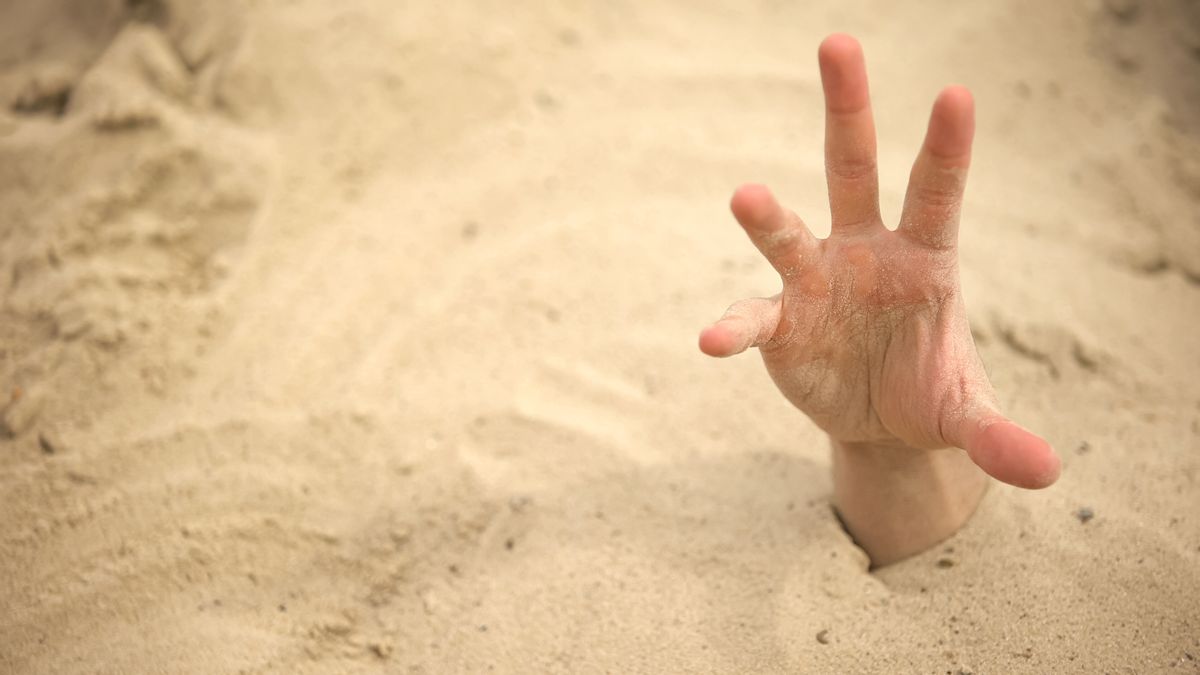Though the threat of drowning in quicksand may be a core fear of any movie buff, some social media users have claimed it is "physically impossible to sink entirely in quicksand."
One Reddit post, which had received more than 12,000 upvotes at the time of this writing, stated as much in August 2024.
TIL It's physically impossible to sink entirely in quicksand
byu/valledweller33 intodayilearned
In short, due to the physical properties of quicksand, a person can sink into a pit of the sand, clay and water mixture. However, because humans are less dense than quicksand, it is indeed physically impossible — under most conditions — for a human or other mammal to fully submerge below quicksand's surface.
This can be explained through a study of physics related to the properties of quicksand.
What Is Quicksand?
Natural quicksand is a mixture of fine sand, microscopic particles of clay, and water, according to the Australian Academy of Science. When left alone, this "special mixture" will become firmer, and more viscous, but a sudden change in pressure at the surface can rapidly liquefy the liquid mixture. In some cases, water can upwell from an underground source, which breaks up sand or clay that would otherwise become packed down and hardened.
These sorts of liquid mixtures are known as "shear-thinning thixotropic non-Newtonian fluids" because they don't appear to follow the normal rules of liquids and solids. Much like toothpaste or hair gel, these mixtures appear solid but flow like a fluid when pressure or force is applied.
Humans Are Less Dense than Quicksand
This type of pressure is known as "yield-stress." For quicksand, that stress is very low — a less than 1% change in weight on the surface of quicksand is enough to liquefy it, according to researchers in a 2005 study.
Quicksand, the study authors wrote, acts as a trap because it becomes unstable when it is forced to move, causing it to liquefy and then collapse. The higher the stress, the more liquid the quicksand becomes, meaning that movement by a trapped body may cause it to sink more deeply.
The reason it is so difficult to escape from once submerged is because its apparent viscosity — thickness or density — increases after it liquefies due to weight being applied. Per the study:
After liquefaction, the quicksand is seen to segregate into a water-rich phase and a sand-rich one. The apparent viscosity increase is therefore due to the formation of sand sediment, which has a very high volume fraction (φ≈0.8) and viscosity. It is the difficulty of moving this densely packed, wet sand that leads to trapping. Water must be introduced into the compacted sand to liquefy it, which requires huge forces: to introduce water at a speed of 1 cm s−1, say, a pressure of 106 pascals (Pa) is needed, assuming a typical sand-pore size of 10 μm. To pull out a foot at this speed, a force of some 104 newtons is required — about that needed to lift a medium-sized car.
However, the researchers said it is "impossible" for an object of certain densities — such as a human or animal — to completely sink below the surface of the quicksand. The density of quicksand is about 2 g ml (grams per milliliter)−1, whereas the average human density is roughly half that.
They reached this conclusion by creating quicksand in a laboratory and placing an aluminum bead mimicking the density of a person on its surface. When they applied force, like that of a person stepping on the quicksand, the bead sunk partially into the quicksand, rather than entirely.
"Any unfortunate victim should sink halfway into the quicksand, but could then take solace from the knowledge that there would be no risk of being sucked beneath the surface," the study authors concluded.
In a separate article, the same researchers once again wrote about using lab-created quicksand to test three common quicksand scenes often depicted in Hollywood films.
They compared quicksand to thick yogurt that has then been stirred. When movement occurs, it liquefies, causing the below structure of the quicksand (or yogurt) to collapse. This can create a "very densely packed sand layer around your feet" that makes it nearly impossible to escape from unless water is introduced to liquefy and break up the sand.
Therefore, they said myth one — that someone shouldn't move when stuck in quicksand — is true. They also considered myth two — that it is impossible for a human to get out when completely stuck in quicksand — true, unless water is added to the mixture and "difficult" extraction techniques are used.
However, again, they wrote that becoming stuck does not mean a person will sink below the quicksand's surface: "A simple experiment in fact shows that it is close to impossible for people or animals (including camels) to drown. The bottom line is that the density of quicksand is roughly twice that of water, and that the buoyancy force will simply make you float."
To demonstrate this concept, the authors used a "Taz" figurine "carefully engineered" to have the density of "men and mammals." They then vibrated the container with Taz in it to mimic someone moving in quicksand.
"We observe that indeed, he sinks away, and more quickly so if we shake harder. Still, however hard we try, we never succeed in drowning Taz completely," wrote the study authors.

(EuroPhysicsNews)
Becoming Trapped in Quicksand Presents Very Real Dangers
However, the study authors warned that the myth of drowning or being sucked into quicksand is likely linked to the location in which quicksand is found: river estuaries.
"The problem one may encounter then is the high tide coming in when one is stuck in quicksand: in this situation drowning is unfortunately very well possible," concluded the study authors.
Speaking to National Geographic in 2005, the team explained that simple movements are the key to escaping from quicksand.
"The way to do it is to wriggle your legs around. This creates a space between the legs and the quicksand through which water can flow down to dilate [loosen] the sand," study co-author Daniel Bonn told the publication. "You can get out using this technique, if you do it slowly and progressively."
More serious concerns involving becoming stuck in quicksand come with the potential for hypothermia, exposure, dehydration, or incoming tides.

